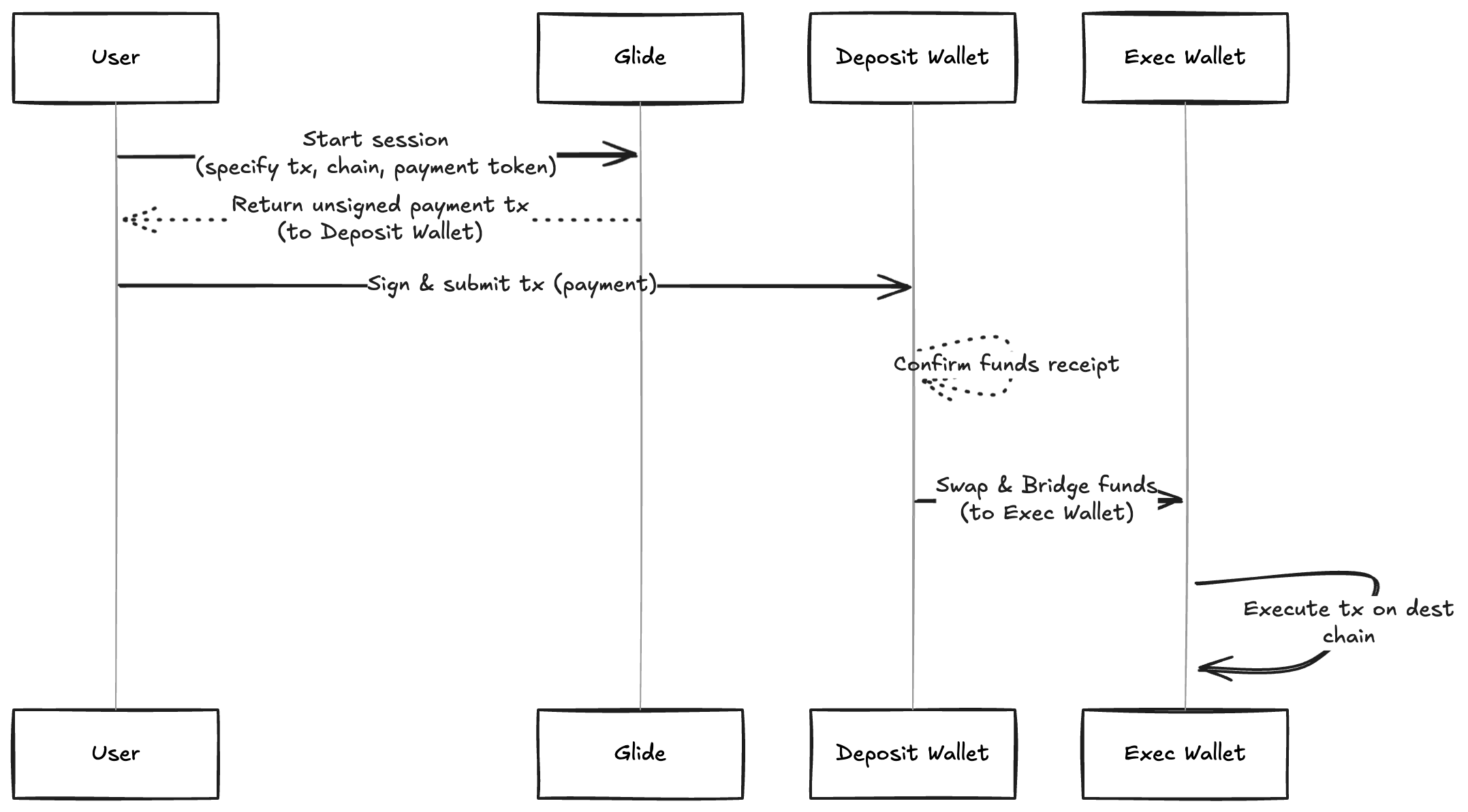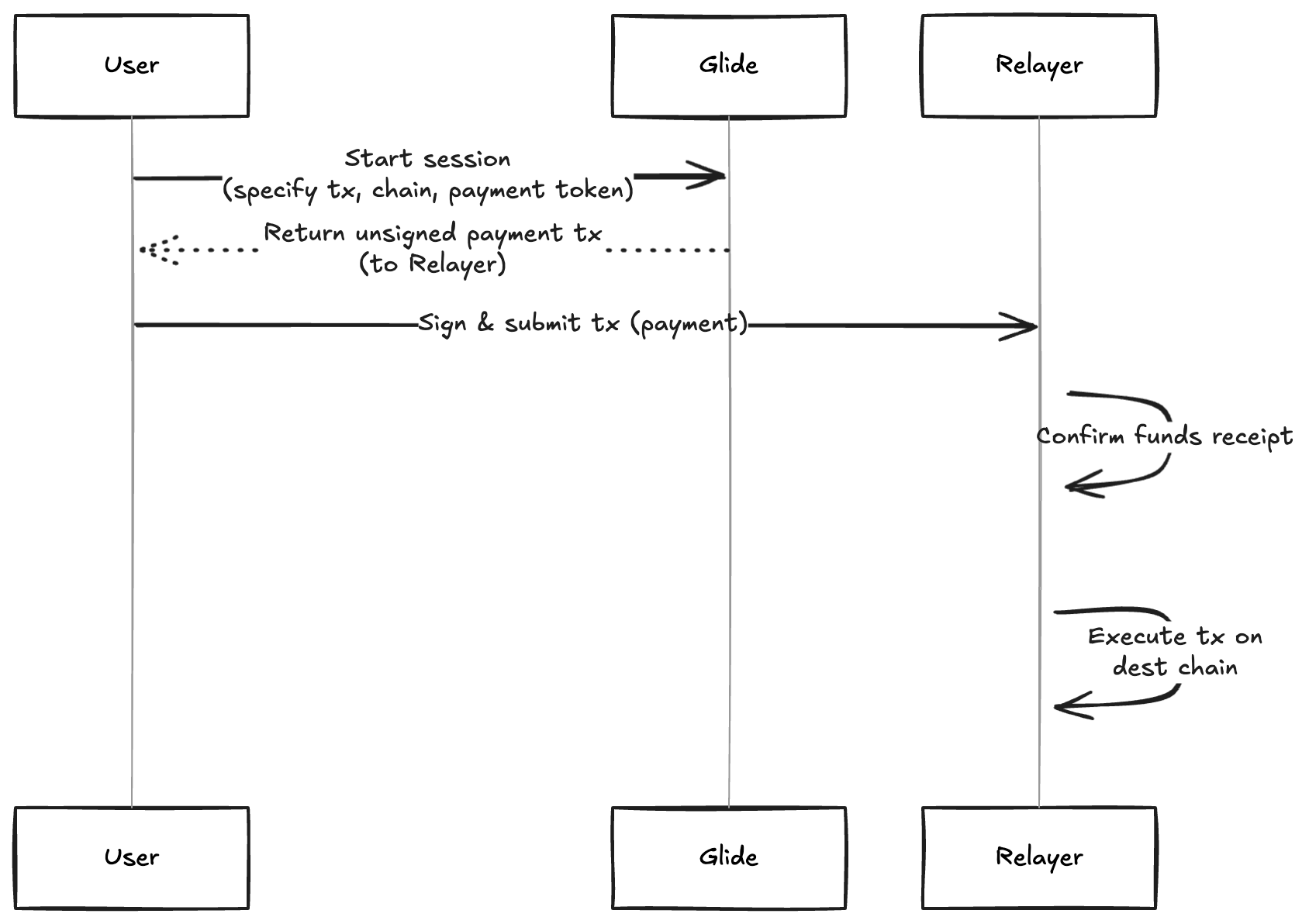How it Works
Table of Contents
- Introduction
- Transaction Modes
- Protocol Goals
- System Architecture
- Instant Relayer Model
- Role of Glide
Introduction
Glide is a cross-chain transaction protocol that enables transparent, on-chain asset transfers and contract interactions across multiple blockchain ecosystems. It supports two primary transaction modes—relayer-based instant execution and bridging-based routes (with optional DEX swaps)—dynamically selected based on speed, cost, and liquidity. By operating fully on-chain, Glide ensures verifiable and trust-minimized execution.
Transaction Modes
- Relayer-Based Transactions — Near-instant cross-chain execution using a relayer. Best for speed.
- Bridging-Based Routes — Canonical or third-party bridges plus optional DEX swaps. Slower but often lower cost.
Protocol Goals
- Instant Execution & Flexibility — Use a relayer for rapid execution; default to bridging or DEX swaps when necessary.
- Arbitrary Transaction Support — Facilitate transfers, swaps, and cross-chain contract interactions.
- Cross-Chain Compatibility — Support EVM, Solana, Bitcoin, and more.
- Security & Trustlessness — Leverage on-chain verifiability to ensure transparency where possible.
- Optimized UX — Provide single-click transactions.
- Scalability — Expand multi-chain support with minimal overhead.
- On-Chain Transparency — Keep all fund movements auditable and trackable.
System Architecture
Transaction Lifecycle
-
Session Initialization — The user specifies their payment token, the transaction details, and execution preference (fastest, cheapest, or auto).
-
Route Determination — Glide selects the optimal path:
Option Speed Cost Capacity Supported Chains Instant Relayer Fastest Higher Limited Many Canonical Bridges + DEXs Slowest Lowest Unlimited Limited Third-Party Bridges + DEXs Varies Varies Very High Moderate -
Payment Transaction — The user performs a single-action payment transaction on the origin chain.
-
Execution — Glide completes final settlement on the destination chain.
Bridging Flow (EVM & Solana)

- Deposit Wallet Creation – Glide generates a dedicated deposit wallet for the user. On EVM, this wallet is created using the
create2opcode, ensuring deterministic address generation. - User Transfer – The user transfers tokens to the deposit wallet.
- Automated Swap & Bridge – If required, the wallet executes an on-chain DEX swap before bridging the resulting tokens via a canonical or third-party bridge. The deposit wallet contains predefined logic for these steps.
- Destination Execution – The bridged tokens arrive at either:
- The User’s Final Wallet, if no further operations are needed.
- An Execution Wallet, if additional contract calls or swaps are specified.
- Completion – If an execution wallet was used, it finalizes the requested logic. The user ultimately receives their assets or the resulting contract outputs in their wallet.
Relayer Flow (Instant Execution)

- Origin Transfer – The user sends tokens to Glide’s relayer address on the origin chain.
- Relayer Destination Liquidity – After confirmation on the origin chain, Glide (operating as the relayer) provides assets on the destination chain.
- Instant Execution – Glide executes the user’s transaction within seconds, bypassing conventional bridges.
Instant Relayer Model
Today, Glide operates its own relayer service to enable immediate cross-chain settlement, removing dependency on bridging steps. Glide maintains liquidity on destination chains, allowing prompt execution of user transactions.
Dispute resolution is currently handled off-chain via Glide’s customer support. If users encounter issues, they reach out to Glide’s support, and Glide investigates and resolves the matter.
Role of Glide
Glide acts as the orchestrator and core technology provider in the cross-chain transaction process. It offers APIs for users and integrators to query fee estimates, pricing, and available routes, ensuring they can select the optimal transaction path. Glide also manages user sessions, collecting necessary transaction parameters and fulfilling them via its in-house relayer.